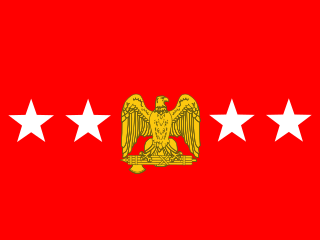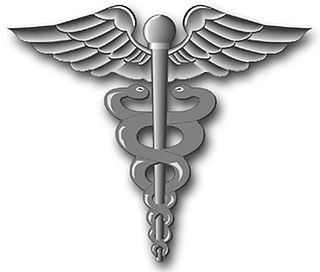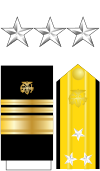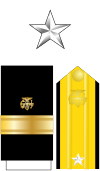The United States has eight federal uniformed services that commission officers as defined by Title 10 and subsequently structured and organized by Titles 10, 14, 32, 33 and 42 of the U.S. Code.

The surgeon general of the United States is the operational head of the United States Public Health Service Commissioned Corps (PHSCC) and thus the leading spokesperson on matters of public health in the federal government of the United States. The Surgeon General's office and staff are known as the Office of the Surgeon General (OSG), which is housed within the Office of the Assistant Secretary for Health.
In the United States Navy, officers have various ranks. Equivalency between services is by pay grade. United States Navy commissioned officer ranks have two distinct sets of rank insignia: On dress uniform a series of stripes similar to Commonwealth naval ranks are worn; on service khaki, working uniforms, and special uniform situations, the rank insignia are identical to the equivalent rank in the US Marine Corps.
Ensign is a junior rank of a commissioned officer in the armed forces of some countries, normally in the infantry or navy. As the junior officer in an infantry regiment was traditionally the carrier of the ensign flag, the rank acquired the name. This rank has generally been replaced in army ranks by second lieutenant. Ensigns were generally the lowest-ranking commissioned officer, except where the rank of subaltern existed. In contrast, the Arab rank of ensign, لواء, liwa', derives from the command of units with an ensign, not the carrier of such a unit's ensign, and is today the equivalent of a major general.

General of the Armies of the United States, more commonly referred to as General of the Armies, is the highest military rank in the United States Army. The rank has been conferred three times: to John J. Pershing in 1919, as a personal accolade for his command of the American Expeditionary Forces during World War I, and to George Washington in 1976, as a posthumous honor during the United States Bicentennial celebrations. In December 2022, Congress authorized the president to posthumously appoint Ulysses S. Grant to the rank.

Admiral of the Navy was the highest-possible rank in the United States Navy, prior to the creation of fleet admiral in 1944. The rank is considered to be at least equivalent to that of a five-star admiral, with Admiral George Dewey being the only officer to be appointed to the rank.

The United States Public Health Service Commissioned Corps, also referred to as the Commissioned Corps of the United States Public Health Service, is the uniformed service branch of the United States Public Health Service (PHS) and one of the eight uniformed services of the United States alongside the United States Army, Navy, Marine Corps, Coast Guard, Air Force, and Space Force and the NOAA Commissioned Officer Corps. The commissioned corps' primary mission is the protection, promotion, and advancement of health and safety of the general public.
In the United States Armed Forces, a line officer or officer of the line is a U.S. Navy or U.S. Marine Corps commissioned officer or warrant officer who exercises general command authority and is eligible for operational command positions, as opposed to officers who normally exercise command authority only within a Navy Staff Corps. The term line officer is also used by the U.S. Air Force and U.S. Coast Guard to indicate that an officer is eligible for command of operational, viz., tactical or combat units. The term is not generally used by officers of the U.S. Army – the roughly corresponding Army terms are basic branch and special branch qualified officers, although the concepts are not entirely synonymous, as some Army special branch officers are eligible to hold command outside their branch specialty.

A hospital corpsman is an enlisted medical specialist of the United States Navy, who may also serve in a U.S. Marine Corps unit. The corresponding rating within the United States Coast Guard is health services technician (HS).

The Army Medical Department of the U.S. Army (AMEDD), formerly known as the Army Medical Service (AMS), encompasses the Army's six medical Special Branches. It was established as the "Army Hospital" in July 1775 to coordinate the medical care required by the Continental Army during the Revolutionary War. The AMEDD is led by the Surgeon General of the U.S. Army, a lieutenant general.
Admiral is a four-star commissioned officer rank in the United States Navy, the United States Coast Guard, and the United States Public Health Service Commissioned Corps with the pay grade of O-10. Admiral ranks above vice admiral and below fleet admiral in the Navy; the Coast Guard and the Public Health Service do not have an established grade above admiral. Admiral is equivalent to the rank of general in the other uniformed services. The National Oceanic and Atmospheric Administration Commissioned Officer Corps has never had an officer hold the grade of admiral. However, 37 U.S.C. § 201 of the U.S. Code established the grade for the NOAA Corps, in case a position is created that merits the four-star grade.

In the United States Armed Forces, the ranks of warrant officer are rated as officers above all non-commissioned officers, candidates, cadets, and midshipmen, but subordinate to the lowest officer grade of O‑1. This application differs from the Commonwealth of Nations and other militaries, where warrant officers are the most senior of the other ranks, equivalent to the U.S. Armed Forces grades of E‑8 and E‑9.

United States Marine Corps rank insignia are the devices worn by officers in the United States Marine Corps, in order to provide distinction from other ranks. Different styles of rank insignia are worn on different uniforms of the United States Marine Corps.
United States Coast Guard officer rank insignia describes an officer's pay-grade. Rank is displayed on collar devices, shoulder boards, and on the sleeves of dress uniforms.
In the United States Armed Forces, a major general is a two-star general officer in the United States Army, Marine Corps, Air Force, and Space Force.

A rear admiral in the uniformed services of the United States is either of two different ranks of commissioned officers: one-star flag officers and two-star flag officers. By contrast, in most other countries, the term "rear admiral" refers only to an officer of two-star rank.

Lieutenant commander (LCDR) is a senior officer rank in the United States Navy, the United States Coast Guard, the United States Public Health Service Commissioned Corps, and the National Oceanic and Atmospheric Administration Commissioned Officer Corps, with the pay grade of O-4 and NATO rank code OF-3. Lieutenant commanders rank above lieutenants and below commanders. The rank is also used in the United States Maritime Service. The rank is equivalent to a major in the United States Army, United States Air Force, United States Marine Corps, and United States Space Force.
Vice admiral is a three-star commissioned officer rank in the United States Navy, the United States Coast Guard, the United States Public Health Service Commissioned Corps, and the National Oceanic and Atmospheric Administration Commissioned Officer Corps, with the pay grade of O-9. Vice admiral ranks above rear admiral and below admiral. Vice admiral is equivalent to the rank of lieutenant general in the other uniformed services.
A general officer is an officer of high military rank; in the uniformed services of the United States, general officers are commissioned officers above the field officer ranks, the highest of which is colonel in the Army, Marine Corps, Air Force, and Space Force and captain in the Navy, Coast Guard, Public Health Service Commissioned Corps (PHSCC), and National Oceanic and Atmospheric Administration Commissioned Corps (NOAACC).



















